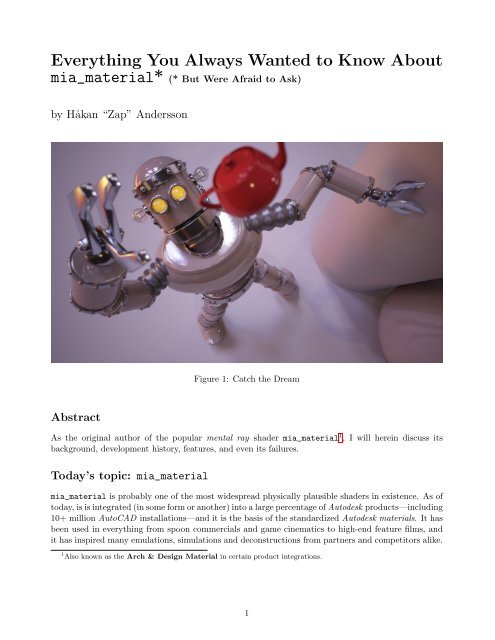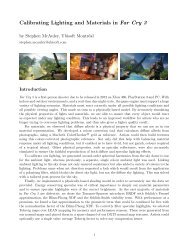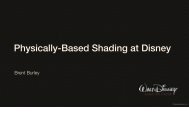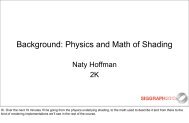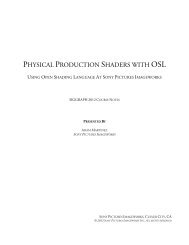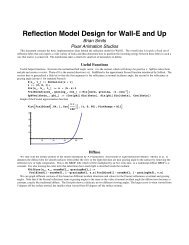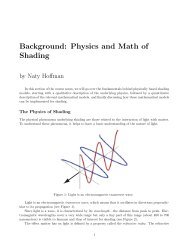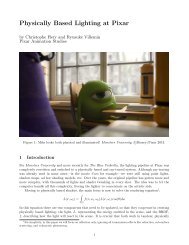course notes - Self Shadow
course notes - Self Shadow
course notes - Self Shadow
Create successful ePaper yourself
Turn your PDF publications into a flip-book with our unique Google optimized e-Paper software.
The Shader: its features and behaviorThe full documentation of the shader and all of its parameters is beyond the scope of this document,but a good reference can be found here: http://download.autodesk.com/us/maya/2009help/mr/shaders/architectural/arch_mtl.htmlMaterial LayersThe material consists of four basic layers, and these are conceptually combined “on top” of each otheras follows:• Reflections / Coating• Diffuse• Refractions (referred to as transparency from this point on)• TranslucencyFigure 2: The various layersThis ordering becomes relevant for the energy conservation algorithm. For instance, since the reflectionlayer is conceptually on top, it “steals” energy 8 from anything below it.8 This is covered in more detail in the Energy Conservation section.4
Energy ConservationEnergy conservation follows by a fairly simple set of rules:• Reflection takes energy from everything below it• Transparency takes energy from diffuse• Translucency is considered to be a “kind of” transparency, and therefore shares remaining energywith it 9In practice, when layer A “takes energy from” layer B, it means that layer B’s contribution is multipliedby 1 minus the contribution of layer A. To avoid color shifting, this is done equally per channel, so thecontribution is based on the luminance-weighted R, G, B components. Therefore, a red reflection doesnot just remove “red energy” (which would, to the user’s surprise, tint underlying layers cyan). Instead,it subtracts the same amount from all channels. The value used is the amount of red multiplied bythe luminance weight of the red channel (for the current color space). This is technically wrong butsince most of the energy loss comes from the reflectivity layer—which is generally white—we rarely seeproblems. In pseudocode form, this amounts to:float3 reflect = apply_view_dependent_curve()float3 diffuse = ;float3 refract = ;float3 transl = ;float orig_transl = luminance(transl);// Energy conservation mathdiffuse *= (1 - luminance(refract)); // Reduce by transparencytransp *= (1 - luminance(reflect)); // Reduce by reflectivitydiffuse *= (1 - luminance(reflect)); // Reduce by reflectivitytransl *= refract; // Scale by transparencyrefract *= (1 - orig_transl); // Compensate by reducing by orig. translucencyAt this point the variables diffuse, reflect, refract and transl contain the absolute weight of each ofthe components. Slightly more complex rules are used if the metal mode is enabled; reflectivity coloris multiplied by the diffuse color, but the energy conservation operates as if reflectivity had retainedits original color.9 This is admittedly a bit inconsistent and was caused by translucency being added later.6
Reflection “Stretchiness”A second issue with many existing shading models is how they fail to recreate the “stretchiness” ofreflections to the extent that reality seems to do. As an example of this, let us consider a sunset over alake. Why does the Sun’s reflection turn into this vertical streak, rather than just a fuzzy highlight?Figure 8: A stretchy highlight.The answer to this question is simple: the normal varies across the lake surface effectively randomlywith the many tiny waves on the surface. But what happens to the reflection direction as the normalvaries on a horizontal surface such as this water?• If the normal is varying away from or towards the viewer, the reflection direction varies massivelyup or down the sky.• If the normal is varying side to side, it hardly affects the reflection direction at all.10
geometry normal, there is always a risk of the reflection direction ending up below the plane, causinga self-intersection with the surface if one tries to trace that ray. Most renderers reject such rays, ortreat them as black, which is often a cause of dark edges in glossy reflection models. In contrast,mia_material simply flips such rays to be above the plane instead, which seems to work well inpractice.A visual comparison of the two methods:Figure 11: Solving reflection rays that go below the plane.Figure 12: In this image, we see mia_material reflections on the left, and standard mental ray Wardreflections on the right.The reflection of the sphere is properly stretched out on the left, but is just a fuzzy, vaguely Gaussianblob on the right. The reflection of the teapot on the right just looks strange.However, all of the above caused one of the biggest problems with the shader, as I will discuss inthe following section.12
Failure is Always an OptionLife is not always optimal, and there are a couple of known issues with mia_material.Highlights versus ReflectionsA major flaw in mia_material is the simple fact that reflections and specular highlights do not match!They may be extremely beautiful individually, but they are supposed to express the same math in twodifferent ways. Alas, they do not 19 :Figure 13: Specular highlight (left) vs. glossy reflection (right) at glossiness=0.54.There are several reasons for this discrepancy:• Highlights use the a sum of three Ward highlights with three different levels of glossiness• Reflections only use a single function with a single glossiness, not three• The unorthodox method to compute the reflection ray directions ends up being a different distributionthan the highlights 20This has to be the issue to look out for if one is trying to match mia_material in some otherrenderer. Without cloning this behavior, it will be practically impossible to get an identical “look”.Conservation Math is “Wrong”The Energy conservation math uses a slightly bizarre algorithm when a layer takes energy from anotherlayer. As mentioned previously, it bases the reduction in energy on the luminance-weighted color value.Without doing this, if one has a 100% red reflection layer there would be zero energy left for diffusereflections, since 100% has already been taken. Or alternatively, it would only reduce the energy inthe red channel, causing a cyan tint of the underlying layers. We felt either of those results would feelconfusing to the user. Instead, mia_material considers the 100% red to be only 21% 21 of the totalenergy, and the remaining 79% can be used for diffuse.19 As I said, “I’m not a Mathematician, I’m a Magician”20 If it is any consolation, had the standard mental ray API function been used to create the reflections, they still wouldnot have matched.21 Assuming sRGB color primaries, where the weight of the red channel is 21%.13
Fixed LayersMany real world materials need more than the four predefined layers of mia_material to be accuratelyportrayed. For example, car paint would need colored glossy reflection and white specular clear-coatreflections. This is impossible to achieve with a single mia_material instance, and whilst it is possibleto blend multiple materials using a color mixing shader, this is highly inefficient 22 . It will also notwork with shadow and photon shaders, which work inherently differently in mental ray and so can’tjust be mixed in that way.Missing EffectsFinally, mia_material doesn’t support subsurface scattering and a few other shading effects that maybe desirable. So as a “do everything” material, it fails to actually do everything.Tiny Bumps are HardAnother more general problem that isn’t specific to mia_material is the problem of small (subpixel)bumps getting prematurely filtered.In reality, all glossiness effects are actually the result of some form of sub-pixel structure. Butwhen a traditional bump or normal map gets filter prior to shading, this effect goes away with thefiltering. It may look fine in a close up where every little bump is visible, but seen at a distance wherefor example every screen pixel covers 100 normal map pixels (causing the normal map to get heavilyfiltered) the effect breaks down and the material appears too shiny.The mia_material lacks any solution to this problem. A few experiments were made to solve it,but none were ultimately successful. For example: instead of filtering 100 normals down to a singlenormal and shading that, we attempted to actually sample the light once, and re-using this light sampleshade each of the 100 normals. This turned out to be way too slow to be usable, and was never actuallyadded.Figure 14: Filtering a normal-map down to a single normal (left) vs. shading all normals and filteringthe result (right)22 Each material would run its own light loop and trace its own set of rays, quickly exploding render times.14
Going ForwardThe experience of creating mia_material and seeing it spread throughout the industry has been aninteresting and rewarding experience. But what can we learn from all this?Highlight and Reflection Appearance is ImportantOur argument that the Gaussian or cosine-raised-to-a-power look of classic specular models was wrong,and that real-world highlights seem to have a falloff that appears much more exponential in nature waspurely empirical. But in 2012 at least two papers were released that seem to vindicate our observations:• Brent Burley, “Physically-Based Shading at Disney” from SIGGRAPH 2012 23• Joakim Löw, Joel Kronander, Anders Ynnerman and Jonas Unger, “BRDF Models for Accurateand Efficient Rendering of Glossy Surfaces” from Linköping University 24Figure 15: An important graph from the Löw et al. paper.In Figure 15 (a), the red line is measured data, the blue line is the model proposed in the paperand the green line is Cook-Torrance. The difference between image (c) (their model) and image (d)(Cook-Torrance) shows exactly the visual problem we witnessed when studying many available glossymodels empirically. Clearly, more research needs to go into this area.23 http://blog.selfshadow.com/publications/s2012-shading-<strong>course</strong>/24 http://vcl.itn.liu.se/publications/2012/LKYU12/15
Reflection Stretchiness and Tiny BumpsA very promising technique that solves both the problems of stretchy reflections and also handles theeffect of tiny bumps seen at a distance can be found in this paper:• Marc Olano and Dan Baker, “Lean Mapping” from Firaxis Games 25 .Flexibility is ImportantThe design of mia_material as a monolithic predefined set of layers was intentional, for performanceas well as ease-of-use reasons, yet it is limiting for the end user. Something more flexible is needed, andin fact there is currently a clear industry move away from shaders as pieces of code, towards materialsas a mixture of atomic BRDFs.Fortunately, a successor to mia_material is currently being developed by NVIDIA ARC 26 basedon a flexible and efficient layering model. These shaders are known as the MILA 27 shaders, and arebased on code I wrote while still an NVIDIA ARC employee, but the shaders have been developedfurther since then. Curious mental ray users can find a beta download of these shaders at the NVIDIAARC forum mentioned below.Figure 16: Dirty glossy skin dipped in strawberry jam, rendered in the MILA shaders.25 http://www.csee.umbc.edu/~olano/papers/lean/26 The company formerly known as mental images GmbH.27 This stands for mental images layering.16
Want to Know More?More information on the mia material and related shaders can be found in the documentation of the Architecturalshader library. Another source of information is my blog at http://www.mentalraytips.com, as well as the user forums at NVIDIA Advanced Rendering Center, found at http://forum.nvidia-arc.com/.Adventurous people can also follow @MasterZap on Twitter but be forewarned, it is mostlyInstagram pictures of Sushi....17


